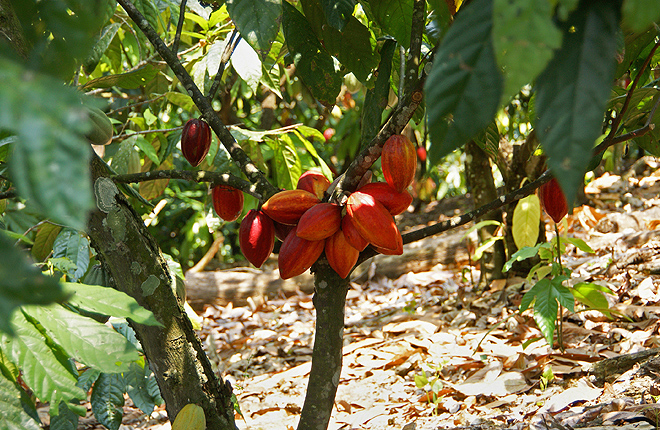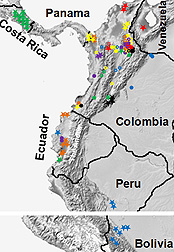Cocoa Pathogen’s Center of Origin Discovered
Imagine a world without chocolate, that distinct and beloved confection derived from the bean of the cacao tree, Theobroma cacao. No more chocolate candy, no more brownies, no more chocolate shakes or other treats.
A certain fungus doesn't care.
|
|
Moniliophthora roreri lurks in most cacao-growing countries of Central and South America. This fungus causes "frosty pod rot," a disease that can destroy as much as 90 percent of the beans from which cocoa, cocoa butter, and ultimately chocolate are made. Growers control frosty pod rot by planting cacao tree cultivars that can tolerate the disease. However, the wily fungus has shown signs of changing its tactics: During the past 15 years, frosty pod rot has infected many cacao varieties once considered highly tolerant to it.
In search of solutions, scientists from the Agricultural Research Service (ARS) and the Centro Agronómico Tropical de Investigación y Enseñanza (CATIE) in Costa Rica focused their attention on decoding the fungus's playbook of life-its genome. "We have sequenced its genome and made some unique observations about how this pathogen survives in cacao plants considered tolerant to infection," says Bryan Bailey, a plant pathologist and team leader with ARS's Sustainable Perennial Crops Laboratory in Beltsville, Maryland. "M. roreri's interaction with cacao is unusual in that it has a biotrophic state [surviving on living tissue] lasting more than 30 days," he says. "A working theory is that the fungus is undergoing genetic changes enabling it to rapidly shift from that state to its necrotrophic state [surviving on dead tissue]."
The research team used genetic sleuthing techniques to trace the fungus to its ancestral home and to reveal new clues about its genetic diversity and ability to adapt to changes in the environment and its host, the cacao tree.
The team examined 172 specimens of frosty pod rot fungus from Bolivia, Colombia, Costa Rica, Ecuador, Peru, and other Latin American countries. Among the findings reported in the August 2015 issue of Frontiers in Microbiology:
- The upper Magdalena Valley of Colombia is the likely center of origin for frosty pod rot and is ground zero for its spread.
- The valley is home to frosty pod rot fungi having the highest levels of genetic diversity, with 16 distinct genetic types occurring there, lending further evidence of the area's center-of-origin status.
The team's discovery is timely. It targets where to begin searching for cacao trees that may harbor new genes for disease tolerance or resistance. Plant breeders could then transfer those genes into currently grown cultivars. Such an advance would benefit growers as well as chocolate lovers worldwide, who consume more than 3 million tons of cocoa beans annually. — By Jan Suszkiw, ARS Office of Communications.
"Cocoa Pathogen's Center of Origin Discovered" was published in the July 2016 issue of AgResearch Magazine.
Key Facts
- Frosty pod rot is a fungal disease that can destroy 90 percent of cacao beans.
- The fungus now infects some tolerant varieties of cacao.
- ARS helped find where to search for trees with new resistance genes.
Full Story









